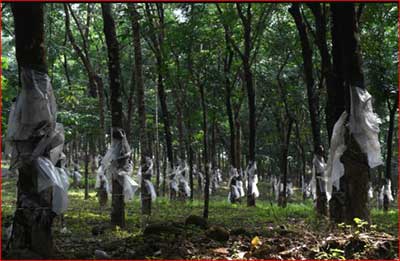Date: 07/11/2022
Relevance: GS-3: Biodiversity, Environment.
Key Phrases: Rubber Board of India, Automotive Tyre Manufacturers’ Association, Natural Rubber, agro-climatically suitable, Hevea brasiliensis, demand-Supply gap.
Context:
- The North-Eastern region, comprising the seven sister states, will likely contribute nearly one-third of the country’s total rubber production soon, thereby helping bridge the demand-supply gap in the rubber industry.
How rubber arrived in North-East India.
- Although Kerala has been a top rubber grower in India, the plant was first introduced in the Northeast by the regional forest department in the 1960s.
- Shifting cultivation couldn’t meet growing aspirations of landless tribals to do better in life, Rubber provided longer term employment and land rights.
- Meanwhile, in the 1980s, the Rubber Board of India, an undertaking of the central government, came to the North-east looking for more land to grow more rubber. The region was agro-climatically suitable.
- The Rubber Board provided a cash subsidy of Rs 30,000 per hectare to grow rubber.
- Gradually even non-tribals took to rubber to make money.
- The Rubber Board got land, and the Tripura government found a central government scheme which it could use for development.
About Rubber Plantation:
- Rubber is a coherent elastic solid obtained from latex of a number of tropical trees of which Hevea brasiliensis is the most important.
- Rubber is used for a variety of purposes from erasing pencil marks to manufacturing of tyres, tubes and a large number of industrial products.
- The first rubber plantations in India were set up in 1895 on the hill slopes of Kerala. However, rubber cultivation on a commercial scale was introduced in 1902.
Conditions of Growth:
- Rubber tree (Hevea brasiliensis) is a quick growing tall tree acquiring 20-30 metre height.
- It begins to yield latex in 5-7 years after planting.
- It requires hot and humid climate with temperature of 25°-35°C and annual rainfall of over 200 cm.
- The rainfall should be well distributed throughout the year.
- Dry spell and low temperatures are harmful.
- Daily rainfall followed by strong sun is very useful.
- Deep well drained loamy soils on the hill slopes at elevation ranging from 300 to 450 metres above sea level provide best conditions for its growth.
- The yields decline at higher elevations and no rubber plantations are found above 700 m elevation.
What is the current project?
- Under a project launched by the Automotive Tyre Manufacturers’ Association (ATMA) in collaboration with Rubber Board, nearly two lakh hectares (lh) in the north-eastern states and West Bengal will be brought under rubber plantation over a period of five years involving an outlay of ₹1,100 crore.
- The north-eastern states currently account for 18 per cent of the country’s total production, which increased to a nine-year high of 7.7 lakh tonnes (lt) in the last fiscal.
- Once the objective of developing plantations in an additional two lh under the project is achieved, it is estimated that the share of these states will increase to 32 per cent of the total production.
- The availability of land and suitable agro-climatic conditions make the region a favourable destination for growing rubber.
- The project activities are being undertaken in Arunachal Pradesh, Assam, Manipur, Meghalaya, Mizoram, Nagaland, Tripura and West Bengal.
- Assam will have the largest area under plantation at close to one lh.
- Close to 1.65 crore rubber plants have been successfully planted in the region so far.
- Plantation in two lh is estimated to directly benefit about 2.5 lakh farmers and their families.
.jpg)
Significance of the Project:
- Raw Material Security:
- Raw material security has been reckoned as a major area of importance for any country in the new world order.
- Given the importance of such strategic raw material, the country needs to focus on increasing the domestic NR (Natural Rubber) production so as to become self-reliant and avoid dependence on import of this critical raw material to the maximum extent possible.
- Enhancement of Quality:
- Besides plantation, the project entails enhancement of quality of rubber produced through creation of model smoke houses and upgradation of existing smoke houses.
- Overall Development of the region:
- Training and skill development would form a major component of the project and would involve creating infrastructure for training facilities, conducting training programmes for farmers and tappers on best practices and technologies.
Do you know?
- The NR demand-supply gap has been widening in India and at present nearly 40 per cent of the requirement is met through imports.
- The country’s domestic production stood at 7.7 lt in 2021-22 against the consumption of 12.3 lt.
- The tyre industry consumes nearly 70 per cent of the total rubber grown domestically.
- It is estimated that by 2030, the country would require about 20 lt of natural rubber per annum.
Conclusion:
- If we (the demand) continue to grow at the rate at which we are growing then rubber availability would come down to alarming levels.
- There is a huge potential in the north-eastern region, it is like a goldmine.
- This is the first of its kind project in the world where the consuming industry is working in collaboration with government agencies with the objective of increasing availability of this strategic raw material in which India is grossly deficient.
- This project will definitely help in bridging demand-Supply gap of rubber in India.
Sources: The Hindu BL
Mains Question:
Q. How Rubber Cultivation in North-Eastern States is going to bridge demand-supply gap in India? What is the current scenario of rubber production in the country? (250 Words).








